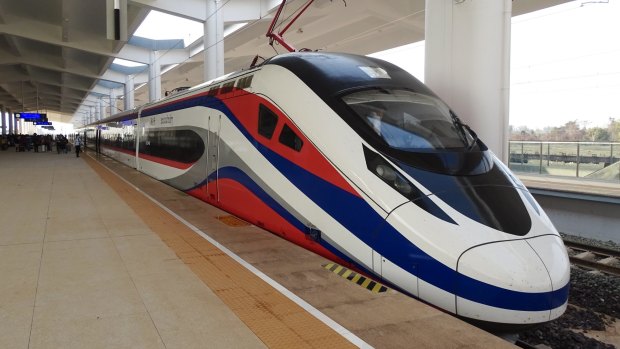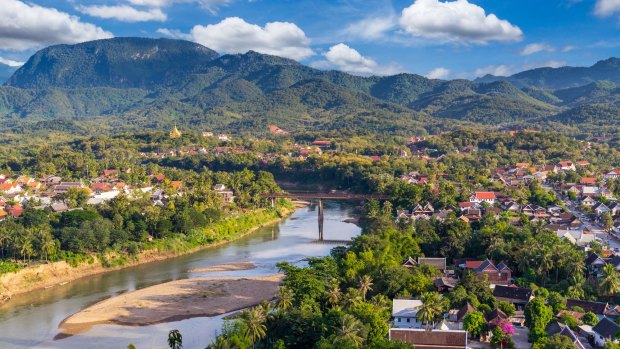This was published 1 year ago
Luang Prabang to Vientiane by train: New railway cuts six-hour journey to two
By Mark Daffey

Laos' new high-speed train cuts the journey between Luang Prabang and Vientiane from six or seven hours to just two.Credit: iStock
It's hot inside Luang Prabang's cavernous railway station terminal. The air-conditioning system is fighting a losing battle, trying to cool the vast emptiness beneath the edifice's upwardly curved, Buddhist temple-style ceilings.
As first impressions go, the building makes a bold architectural statement, perched on a rise, on its own, away from the city. From a practical perspective, it's not the most sensible design. Nor is it centrally located. But in terms of what it symbolises to the people of Laos, it's difficult to overstate just how much the introduction of this railway line could mean for the nation's prosperity.
The opening of the Laos-China Railway on December 3, 2021 was a long time coming. Talks on building a railway line connecting the neighbouring countries started in 2001, but it wasn't until 15 years later that construction started.

There is spectacular scenery in Laos, though you will only get brief glimpses on the train.Credit: tortoon
It was originally planned as a high-speed joint venture between the Laos and Chinese governments – a missing link in a passenger and freight line that would travel through Thailand and Malaysia and eventually connect the Chinese city of Kunming with Singapore, 3900 kilometres to the south. Then a corruption scandal involving the then-Chinese railway minister delayed construction.
Following a strategy aimed at "changing a land-locked country into a land-linked country", government ministers in Laos were determined to push through, downgrading the project to a cheaper, conventional-speed railway with a maximum speed of 160 kilometres an hour instead of 200. The 414-kilometre route would cut through Luang Namtha, Oudomxay, Luang Prabang and Vientiane provinces and integrate 75 tunnels and 167 bridges. Ten passenger stations, most of them similar in scale and design to Luang Prabang's, were added to the blueprints, as well as a further 22 freight stations.
Undetonated bombs leftover from the Vietnam War were removed and an unspecified number of villagers were displaced to make way.
By September 2022, close to seven million passengers had reportedly used the service, helping to vindicate the decision. But it hasn't been without controversy.
As the most expensive infrastructural project ever undertaken in Laos, the government is now heavily indebted to Chinese state-owned banks that financed 70 per cent of the $7 billion cost. Tickets have been difficult to obtain and can be booked no more than 48 hours before departure, with hotels often employing travel agencies to queue up at station ticket offices.
It is expected to become harder once the Chinese border opens and passenger demand increases.
"It was a bit messy when it first opened, though it's getting better. And in smaller stations, like in Oudomxay, you need to arrange your own transport to and from the station," says Australian, Susie Martin, who co-founded Laos' first (and only) buffalo dairy outside Luang Prabang in 2017.
Martin, who has travelled on the train for business and leisure reasons, is buoyed by the potential benefits Laos stands to gain, from both a tourism and freight/trade perspective.
"Given that Luang Prabang is recovering from two-and-a-half years of no tourism, the train line has definitely helped speed up its recovery. Much larger numbers [of tourists] are now able to access Luang Prabang, and more quickly and cost effectively than if they'd come here by plane or mini-van."
I fly into Luang Prabang from Bangkok with my wife and son. After spending three nights in the UNESCO World Heritage-listed town, staying at the Avani+ Luang Prabang hotel, we intend to fly on to Vientiane for two days of sightseeing in the Laotian capital before boarding our plane home to Melbourne. Then three weeks before I leave home, I learn about the new train and decide to change tack.
Travelling by train to Vientiane will save us a bunch of money on flights and be just as quick – quicker, even, when airline check-in requirements and luggage collection delays are considered. And it will allow us to stopover for two days of adventure-packed hijinks in Vang Vieng along the way.
With reserve seats in Second Class, or "Hard Seat", as the Chinese call it, we're directed towards Carriage One. There are eight other carriages, but almost every awaiting passenger is already queued outside ours.
"There's no way everyone is going to fit in," says my wife, Michelle.
Doubts begin to surface. Laotians are new to train travel and don't yet understand the etiquette behind reserved seats. Will someone be sitting in our seats, unwilling to budge?
We needn't have worried. Our back row seats are vacant. Michelle and Finn sit next to each other, across the aisle from me. I'm seated next to an older man who nods when I ask him if he's from Vang Vieng. We don't share a common language, though judging by his enthusiasm for taking in the scenery through the windows early in our journey, I'm guessing it's his first time travelling on the train. Considering there's only one other train line in all of Laos – a four-kilometre-long freight line extension from the Thai border town of Nong Khai – there's a fair chance it might be his first time on any train.
Our train departs at its scheduled time, smoothly and silently pulling away from the station. The comfortable, red velour seats allow ample legroom to stretch out, even when the passenger in front of me reclines his. Power and USB ports are under the seat, and there's a flip-down serving tray on the back of the seat in front.
It takes 50 minutes to reach Vang Vieng, compared to more than four hours by road. Yet when I wander up the aisle during the journey, almost everyone on the train is dozing. I wouldn't have thought they'd bother. But since we spend most of our time tunnelling through mountains, there are only glimpses of scenery to take in through our windows; rice paddies here, jagged limestone peaks there, then we're back in darkness.
The longest stretch of daylight lasts less than two minutes.
It's a different story when we return to the train station in Vang Vieng two days later, ready to continue on to Vientiane. Thai tourists pose for photos outside the terminal building. Buffalo scat litters the carpark.
I scan the list of prohibited items posted at the entry door, then pray that I haven't mistakenly packed a tiger skin in my luggage. Operatic arias that could be mistaken for national anthems blare across the station's PA system.
The landscape is flatter on our second leg so there are fewer tunnels. Buffalo and cattle graze in grassy fields outside our windows. Chicken farms are common. And it's noisier onboard; more passengers are awake this time.
All up, it's takes us less than two hours to travel from Luang Prabang to Vientiane via Vang Vieng, at a cost of about $40 each. By road, that same journey would have taken six or seven hours; longer if it rains. There's really no contest.
FIVE PLACES TO VISIT ALONG THE ROUTE
VIENTIANE
The Laotian capital, fronting the mighty Mekong River across the border from Thailand, is home to golden stupas, grandiose war memorials and a bustling night market.
VANG VIENG
Float down the Nam Song River on tyre tubes, splash into spring-fed lagoons on swing ropes and hike to craggy mountaintop viewpoints in Central Laos' backpacker party town.
LUANG PRABANG
Rise before dawn to witness Buddhist monks parading through this charming town's World Heritage-listed streets, explore centuries-old Buddhist temples or wile away the hours in a cafe overlooking the Mekong or Nam Khan Rivers.
MUANG XAI
The provincial capital of Oudomxay, close to the Nam Ko River basin, is known for its dramatic mountain scenery and caving opportunities.
LUANG NAMTHA
Visitors come here to trek through jungles and mingle with ethnic tribes. The closest railway station is at Na Teuy, 30 kilometres away.
THE DETAILS
FLY
Thai Airways flies daily from Sydney, Melbourne and Brisbane, and three times weekly from Perth, to Bangkok, with daily connections on to Vientiane. See thaiairways.com
TOUR
Tickets for the Laos-China Railway can only be bought at stations along the route within 48 hours of travelling, or at ticket offices in Vientiane and Luang Prabang. One-way tickets must be paid using cash. Online bookings are currently unavailable. For a small fee, our hotel in Luang Prabang employed a local travel agent to purchase tickets to Vang Vieng, and again on to Vientiane, on our behalf.
STAY
The Avani+ Luang Prabang hotel is conveniently located opposite the Luang Prabang Night Market, with rooms from $237 a night. See avanihotels.com
MORE
The writer was a guest of the Minor Hotels group that includes Anantara and Avani.
Sign up for the Traveller Deals newsletter
Get exclusive travel deals delivered straight to your inbox. Sign up now.